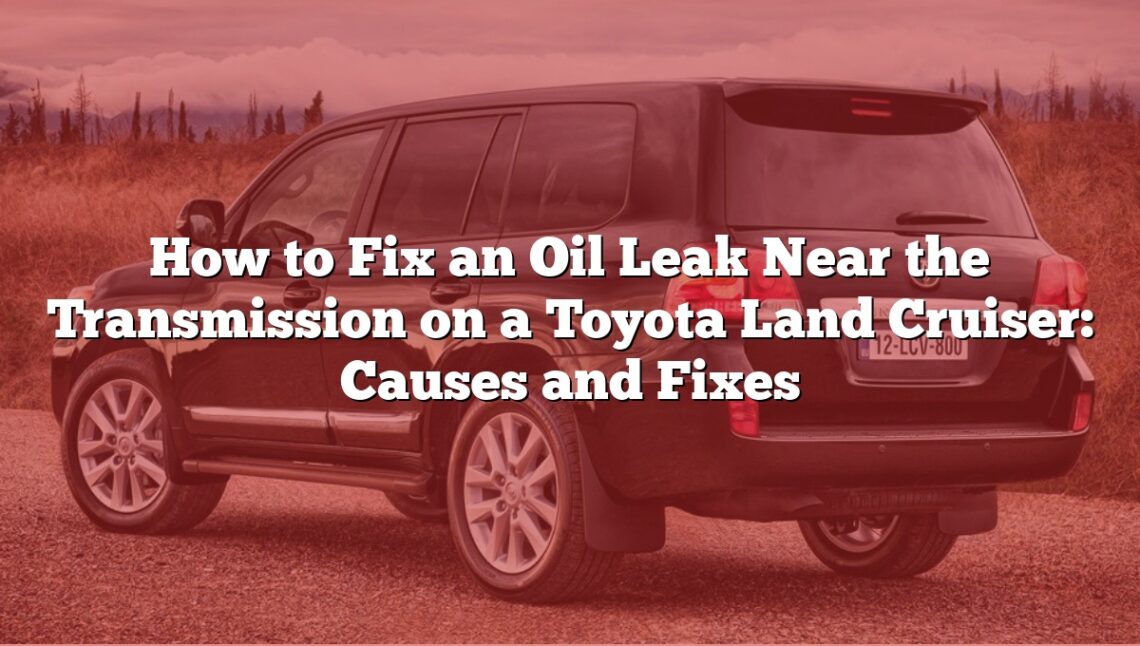Oil leaks near the transmission can be a frustrating and potentially costly issue for Toyota Land Cruiser owners. Understanding the common causes of these leaks and knowing how to address them effectively can save time, money, and the health of your vehicle. This guide dives into the 28 most common reasons behind oil leaks and provides clear, actionable solutions to keep your Land Cruiser running smoothly.
Causes and Solutions for Oil Leaks Near the Transmission or Engine
| N° | Problem/Cause | Possible Solution |
|---|---|---|
| 1 | Worn or damaged transmission seals | Replace the damaged seals. |
| 2 | Faulty input shaft seal | Replace the input shaft seal. |
| 3 | Damaged output shaft seal | Replace the output shaft seal. |
| 4 | Cracked transmission housing | Repair or replace the transmission housing. |
| 5 | Loose transmission pan bolts | Tighten the transmission pan bolts to specification. |
| 6 | Faulty or degraded transmission pan gasket | Replace the transmission pan gasket. |
| 7 | Overfilled transmission fluid | Drain excess fluid to the proper level. |
| 8 | Clogged or damaged transmission breather | Clean or replace the transmission breather. |
| 9 | Leaking torque converter | Inspect and replace the torque converter if leaking. |
| 10 | Damaged or degraded rear main engine seal | Replace the rear main engine seal. |
| 11 | Cracked or worn transfer case seals | Replace the transfer case seals. |
| 12 | Improperly seated or damaged oil drain plug | Reseat or replace the oil drain plug. |
| 13 | Corroded or damaged transmission cooling lines | Replace the cooling lines. |
| 14 | Leaking oil cooler connection | Tighten or replace the oil cooler connection. |
| 15 | Worn differential pinion seal | Replace the differential pinion seal. |
| 16 | Cross-threaded bolts or stripped threads | Repair or replace bolts/threads as needed. |
| 17 | Oil contamination degrading seal integrity | Clean or replace contaminated seals and fluid. |
| 18 | Wear from high mileage or age-related deterioration | Inspect and replace worn components. |
| 19 | Physical damage from road debris or impacts | Inspect and repair damaged areas. |
| 20 | Improper installation or misalignment of components | Reinstall or align components properly. |
| 21 | Failed gasket (including head gasket or oil pan gasket) | Replace the failed gasket. |
| 22 | Stripped or leaking oil drain plug | Replace the drain plug or repair threads. |
| 23 | Leaking ring or valve seal | Replace the leaking seal. |
| 24 | Damaged oil filter or improperly fitted oil filter | Replace or correctly install a new oil filter. |
| 25 | Failing filler cap on the oil tank | Tighten or replace the filler cap. |
| 26 | Excess engine oil causing overflow and leaks | Drain oil to the recommended level. |
| 27 | Broken valve cover gasket | Replace the valve cover gasket. |
| 28 | Oil degradation causing premature gasket wear | Replace gaskets and use high-quality oil. |
Detailed Guide : Causes and Solutions for Oil Leaks Near the Transmission or Engine
1. Worn or Damaged Transmission Seals
Reason 1: Over time, transmission seals can degrade due to age, high temperatures, or contamination, causing oil leaks. Solution:
- Identify the leaking seal by inspecting the transmission assembly.
- Replace the damaged seals. Use high-quality seals to ensure durability.
Steps:
- Drain the transmission fluid.
- Remove the affected part (e.g., transmission case).
- Carefully remove the old seal.
- Install the new seal and reassemble the parts.
- Refill the transmission with the recommended fluid.
2. Faulty Input Shaft Seal
Reason 2: The input shaft seal can wear out due to friction or misalignment, leading to oil seepage. Solution: Replace the input shaft seal by removing the transmission and carefully installing a new seal to prevent further leaks.
3. Damaged Output Shaft Seal
Reason 3: A worn or cracked output shaft seal can cause oil to escape from the transmission.
Solution:
- Inspect the output shaft area for damage.
- Replace the output shaft seal. Ensure the seal is installed evenly to prevent leaks.
4. Cracked Transmission Housing
Reason 4: Impact damage or manufacturing defects may cause cracks in the transmission housing.
Solution:
- Small cracks can be repaired using high-strength epoxy.
- For extensive damage, replace the transmission housing.
Steps:
- Drain the transmission fluid.
- Remove the housing.
- Weld or apply epoxy to repair small cracks.
- Reassemble and refill the fluid.
5. Loose Transmission Pan Bolts
Reason 5: Bolts can loosen over time due to vibration or improper torque during installation.
Solution:
- Tighten the bolts to the manufacturer’s specifications using a torque wrench.
- Replace any damaged bolts.
6. Faulty or Degraded Transmission Pan Gasket
Reason 6: Gaskets can degrade over time, leading to leaks around the transmission pan.
Solution: Replace the gasket with a new one. Ensure the surface is clean and dry before installing the new gasket.
7. Overfilled Transmission Fluid
Reason 7: Excess fluid can create pressure, causing it to leak from seals or vents.
Solution:
- Drain the excess fluid until it reaches the recommended level.
- Check the transmission vent for proper functioning.
8. Clogged or Damaged Transmission Breather
Reason 8: A clogged breather can cause pressure buildup, forcing oil out through weak seals.
Solution:
- Clean or replace the breather.
- Ensure proper ventilation in the transmission system.
9. Leaking Torque Converter
Reason 9: A damaged torque converter can cause oil to leak from the front of the transmission.
Solution: Replace the torque converter. This requires removing the transmission for access.
10. Damaged or Degraded Rear Main Engine Seal
Reason 10: The rear main seal can wear out due to age or improper installation, causing leaks.
Solution: Replace the rear main seal. This involves removing the transmission and flywheel for access.
11. Cracked or Worn Transfer Case Seals
Reason 11: Seals in the transfer case can crack or degrade, allowing oil to escape.
Solution: Replace the seals and inspect the transfer case for additional damage.
12. Improperly Seated or Damaged Oil Drain Plug
Reason 12: An improperly seated or damaged plug can cause leaks from the oil pan.
Solution:
- Reseat the plug or replace it if damaged.
- Use thread sealant if necessary.
13. Corroded or Damaged Transmission Cooling Lines
Reason 13: Corrosion or physical damage can cause leaks in the cooling lines.
Solution: Replace the damaged lines. Use high-quality replacements to prevent future issues.
14. Leaking Oil Cooler Connection
Reason 14: A loose or damaged connection can cause fluid leaks.
Solution: Tighten or replace the connection and inspect the cooler for damage.
15. Worn Differential Pinion Seal
Reason 15: The differential pinion seal can wear out, causing oil leaks near the differential.
Solution: Replace the pinion seal. Ensure proper alignment during installation.
16. Cross-Threaded Bolts or Stripped Threads
Reason 16: Misaligned threads can cause improper sealing and oil leaks.
Solution: Repair the threads using a thread repair kit or replace the affected bolts.
17. Oil Contamination Degrading Seal Integrity
Reason 17: Contaminated oil can degrade seals, causing leaks.
Solution:
- Replace the contaminated oil and flush the system.
- Inspect and replace degraded seals.
18. Wear from High Mileage or Age-Related Deterioration
Reason 18: Prolonged use can cause seals and components to wear out.
Solution: Inspect and replace worn components. Schedule regular maintenance.
19. Physical Damage from Road Debris or Impacts
Reason 19: Debris or impacts can damage transmission or engine components.
Solution: Inspect the damaged area and replace or repair the affected components.
20. Improper Installation or Misalignment of Components
Reason 20: Poor installation can cause stress on seals, leading to leaks.
Solution: Reinstall or align the components correctly.
21. Failed Gasket (Including Head Gasket or Oil Pan Gasket)
Reason 21: Gaskets can fail over time or due to high pressure.
Solution: Replace the gasket and ensure proper installation with even torque application.
22. Stripped or Leaking Oil Drain Plug
Reason 22: Damaged threads or a loose plug can cause leaks.
Solution: Repair the threads or replace the plug. Use a washer for a better seal.
23. Leaking Ring or Valve Seal
Reason 23: Damaged seals can cause internal or external oil leaks.
Solution: Replace the seals and ensure proper lubrication during installation.
24. Damaged Oil Filter or Improperly Fitted Oil Filter
Reason 24: A damaged or incorrectly installed filter can cause leaks.
Solution: Replace the oil filter and ensure it is fitted correctly. Always use a compatible filter.
25. Failing Filler Cap on the Oil Tank
Reason 25: A loose or broken filler cap can allow oil to leak.
Solution: Tighten the cap or replace it with a new one.
26. Excess Engine Oil Causing Overflow and Leaks
Reason 26: Overfilling can create pressure, causing leaks.
Solution: Drain the excess oil and check the oil level regularly.
27. Broken Valve Cover Gasket
Reason 27: A broken gasket can cause oil to leak from the top of the engine.
Solution: Replace the valve cover gasket and ensure it is properly seated.
28. Oil Degradation Causing Premature Gasket Wear
Reason 28: Low-quality or degraded oil can cause gaskets to fail prematurely.
Solution: Replace the gaskets and use high-quality oil. Follow the manufacturer’s maintenance schedule.
Preventing Future Issues
To minimize the risk of oil leaks and ensure the longevity of your vehicle’s transmission and engine, follow these preventative steps:
- Regular Maintenance
- Schedule routine inspections of the transmission and engine seals during oil changes or general maintenance.
- Ensure the transmission fluid and engine oil are changed according to the manufacturer’s recommendations.
- Use High-Quality Fluids and Parts
- Always use the recommended grade of engine oil and transmission fluid for your vehicle.
- Replace damaged components with high-quality, compatible parts to ensure durability.
- Inspect for Wear and Damage
- Regularly check for signs of wear, such as cracks, leaks, or degraded seals, especially in high-mileage vehicles.
- Inspect cooling lines, oil pans, and bolts for physical damage after driving on rough terrain or during seasonal changes.
- Tighten Bolts to Specification
- Use a torque wrench to ensure bolts are tightened to the manufacturer’s specifications. Over-tightening can damage seals and threads.
- Avoid Overfilling Fluids
- Use a dipstick to maintain the correct levels of engine oil and transmission fluid.
- Drain excess fluid if levels exceed the recommended range.
- Clean the Transmission Breather
- Ensure the breather is free of debris to prevent pressure buildup that can damage seals.
- Inspect and clean the breather every few months or during maintenance checks.
- Replace Components on Schedule
- Change oil filters, gaskets, and seals at intervals recommended by your vehicle’s manual.
- Pay attention to warning signs like fluid puddles, burning smells, or unusual engine noises.
- Protect Against Physical Damage
- Avoid driving over rough roads or debris that could damage the undercarriage.
- Install skid plates if you frequently drive off-road.
- Monitor Oil and Fluid Quality
- Inspect oil and transmission fluid for discoloration or contamination regularly.
- Flush and replace fluids if contamination is detected.
- Store Your Vehicle Properly
- Keep the vehicle in a sheltered area to prevent weather-related wear on seals and gaskets.
- Avoid extended periods of inactivity, which can cause seals to dry out.
By adhering to these preventive measures, you can significantly reduce the likelihood of oil leaks and ensure the efficient operation of your vehicle for years to come. Regular attention to your vehicle’s health is the key to avoiding costly repairs and maintaining performance.







